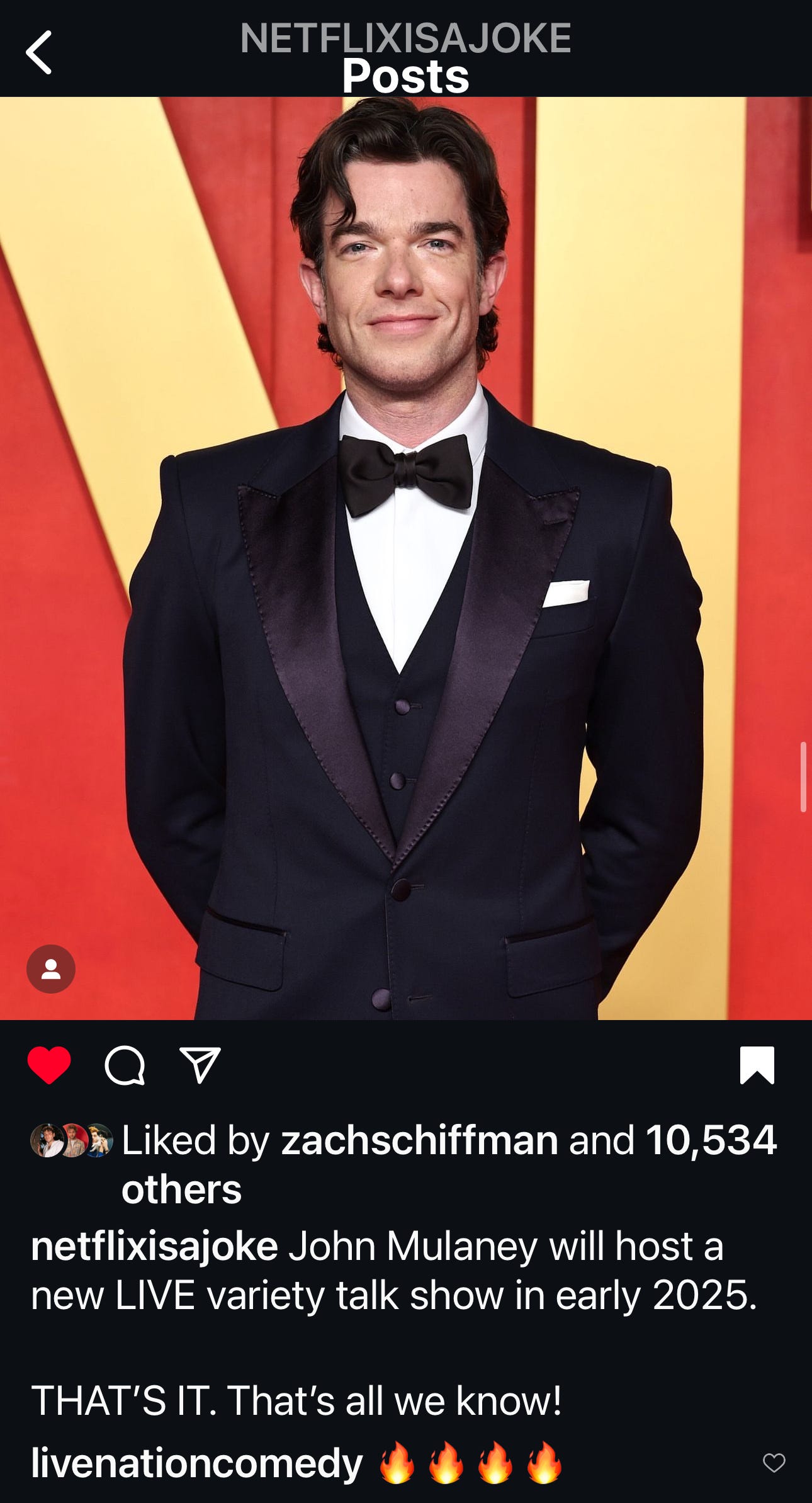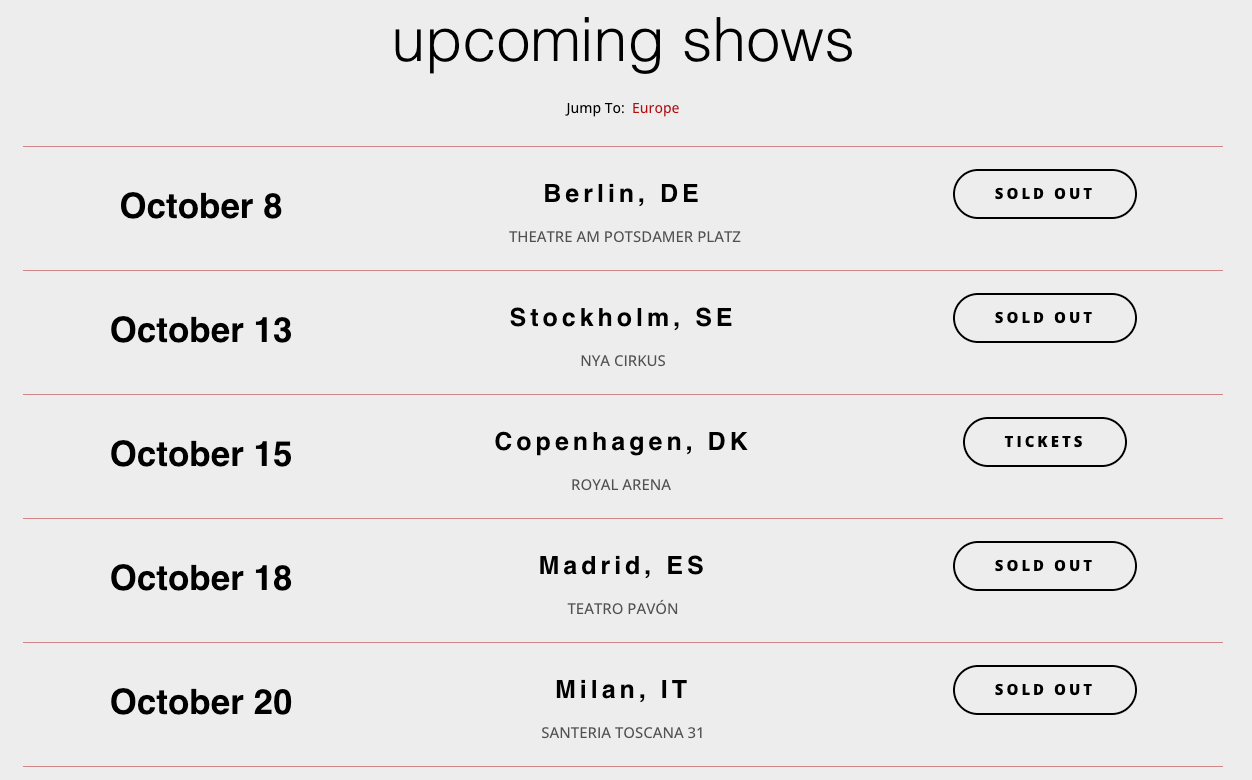Netflix Is Giving John Mulaney A Weekly, Live Talk Show.
Could this signal a larger pivot toward *live* comedy? Should it?
Hello and welcome to the 21 (!!) new subscribers since last week’s piece, Every App is Copying TikTok, Except For the Ones That Should Be. As always, if you find this piece interesting, feel free to forward it along in your company’s #general Slack channel.
I postpotned this week’s scheduled email because an Instagram post from one of the aforementioned “Apps That Should Be Copying TikTok” caught my eye yesterday:
Caption:
@netflixisajoke: John Mulaney will host a new LIVE variety talk show in early 2025.
THAT’S IT. That’s all we know!
And it’s not lost on me that the top comment, 4 fire emojis, comes from Live Nation. Presumably to symbolize what’ll happen to your checking account after using their services to buy tickets to the show’s inevitable residency at the Intuit Dome1.
This news comes on the heels of a six-episode trial run of the Mulaney-led Everybody’s in LA in May, and is part of Netflix’s larger foray into live / eventized programming.
According to this Variety presser:
Live has been a growth area for Netflix, which is in talks with BuzzFeed to air live versions of “Hot Ones,” the popular YouTube talk series hosted by Sean Evans, and has added live sporting events like golf, tennis and boxing; a hot dog eating contest; the “Roast of Tom Brady”; and comedy specials from the likes of Chris Rock and Joe Rogan. Netflix is also soon adding live wrestling programming, as well as a Christmas day set of NFL games.
What’s particularly of note is how they’re “in talks with” airing Hot Ones, a proven, digital show with a wide reach, unique concept, and relatively unknown host.
Meanwhile, when it comes to their in-house ideas, they’ve got it all backwards.
Re-read that Instagram post’s caption:
John Mulaney will host a new LIVE variety talk show in early 2025.
THAT’S IT. That’s all we know!
Cutesiness aside, the only elements solidified are the format and principal talent.
If I was their Content Czar, I would be thinking about this in the opposite order.
The show’s PEMDAS should go: Audience > Insight > Concept > Format > Talent
What audience are we attempting to serve? What do we know about them and their viewing habits? What are some creative concepts that would compel them to subscribe to (or stay on) our platform? Do we have access to internal case studies of similar concepts working or failing that we can review? What sort of structure and format do those concepts succeed in (movie vs. TV series, serial vs. anthological, comedy vs. drama, live action vs. animation, etc.)? What is the financial upside? The risk? The budget? How will we quantify its value? How will we measure its success?
And only then, after all of that information is known and SWOTted and presented and pitched and so on, determining what talent should be attached.
I apologize if that sounds bleak at first glance.
But really, if you’re a presently undiscovered talent, you should sense opportunity.
I should have been in the exact audience for Everybody’s in LA.
From about 2011-2016, Mulaney was my absolute favorite stand-up comedian.
I practically have The Top Part and New in Town memorized. I watched the entirety of his short-lived NBC sitcom. My friends and I drove to Milwaukee to see him live in 2013 instead of going to our “Turnabout” high school formal dance that Spring. Granted, that was largely because no girls asked us to said dance2, but the point stands.
And yet, after an episode and a half of Everybody’s in LA, I disappointingly closed out of Netflix and turned on Nuggets-Timberwolves, or browsed my FYP, or something. Maybe it found its footing in later episodes, but to me, it felt like a stilted, “lawful good” version of The Chris Gethard Show that targeted transplants and coastal elites, as opposed to TCGS’ scrappy, DIY, underdog appeal to misfits and outcasts.
Mulaney's at his best with a script. He’s a master joke writer and teller. The idea of a variety, live show starring him doesn’t really play to his strengths. I didn’t watch his specials over and over as a high schooler because of his dynamic stage presence, or ability to improvise. In fact, I didn’t watch them at all. I listened to them. On iTunes3.
I’d be 10x more excited to see a show written by him where he doesn’t appear in a single scene, than a show he stars in, with only a structural hand in the actual writing.
Contrast Everybody’s in LA with Kill Tony, the self-proclaimed #1 Live Podcast in the World™, which is currently eating everyone else in comedy’s lunch in terms of digital reach, brand awareness, advertising revenue, ticketing upside, and social currency.
I’m not exaggerating.
I was in Iowa City last week for a slate of four Stamptown shows and overheard a shy, CompSci major on a “get coffee and see where it goes” first date meekly explain the concept of Kill Tony to a completely disinterested Chi Omega Swiftie at a local café.
*Bill Simmons voice* That wasn’t happening with Everybody’s in LA, it just wasn’t!!!
But there’s a subtle lesson in how the Hawkeye pitched the show to his Hinge date.
The appeal of Kill Tony is not that it is hosted by Tony Hinchcliffe.
It’s about the concept of watching unknowns get 60 seconds of high-stakes stage time.
Maybe you’ll watch the birth of a superstar. Maybe you’ll witness a glorious bomb.
Either way, you can pack a fat bowl, heat up a frozen pizza, and get cozy as Tony and the guest judges have a field day while roasting the notebook-hopefuls after their set.
Same goes for Hot Ones.
No fan describes that show to their friends by leading with Sean Evans.
It’s about the concept of interviewing celebrities as they eat increasingly spicy wings.
There are so many examples of popular, digital-native “talk shows” successfully pivoting into live shows that follow this, “concept-first” framework.
Take Therapy Gecko. Or UpDating.
These are shows hosted by (no offense) complete industry unknowns that manage to get hundreds of thousands of views per episode on their YouTube channels, and who knows what else in terms of brand partnerships, content monetization, cultural relevancy, and ticket sales, as they start to take these acts on the road.
Hell, here are Therapy Gecko’s past 72 hours:
Instead of creating a talk show from scratch and hoping the public finds it funny, what’s smart about gambling on existing, live formats that already sell out in multiple major markets with repeat customers is you have evidence of it working in a live format.
And just like a TikTok video with only 1,000 views but 200 likes and 100 shares, all you need to do is increase the reach. The Like and Share percentages should hold constant.
If Netflix is actually looking to disrupt the *live* comedy space, then their role as curator should be to identify live shows with highly mobilized fanbases, and leverage its marketing budget, SOV, and international distribution to catapult their reach.
To act as the #fyp or #comedy that sends it out to their millions of paying subscribers.
And then to clean the f**k up on the ticketing front when it becomes the next Kill Tony, doing nationwide tours, and sold-out shows at Madison Square Garden.
Let’s say, for instance, Matt Rife effectively sells out a massive, international arena tour in large part thanks to releasing two Netflix specials in the last twelve months.
Oh wait…
Shouldn’t the distributor be incentivized to recoup some of that ticketing upside?
Maybe if only one comedian hits it big per year, it’s not an avenue worth exploring.
But couldn’t this grow into a meaningful revenue stream for Netflix, especially when they’ve released a new stand-up comedy special every week for what feels like the last seven years, and continue to build their whole “Netflix is a Joke” subsidiary brand?
I have no idea what the slicing of the ticket pie looks like for comedians who blow up and tour the world c/o Netflix, or if that’s all small potatoes for a FAANG company.
But if I’m Live Nation, that makes me go 🔥🔥🔥🔥🔥🔥🔥🔥.
David Zucker is a digital marketing consultant based in New York City. A former analyst at TikTok, his unique, data-driven approach has catapulted the growth of his clients’ audiences all over the world. He also happens to have oculocutaneous albinism, a rare genetic disorder which renders him legally blind. This condition offers him a unique perspective on both live and digital comedy, especially with respect to accessibility. To schedule a consult, click here.
Great to be here, what a crowd.
Likely because we were the sort of guys who did things like drive to Milwaukee on a Friday night to see a relatively unknown stand-up comedian, but I digress…
Then again, I’m half-blind, so YMMV.






